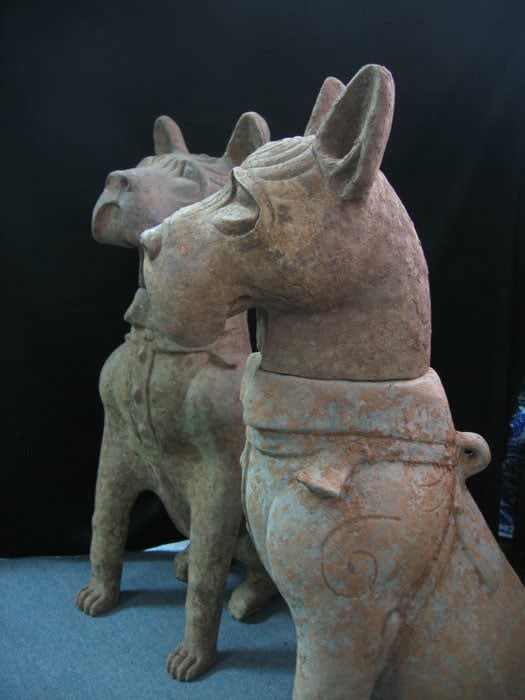Han Dynasty Painted Pottery Pair of 'Sichuan' Sitting Dogs, 206 BCE - 220 CE
Terracotta
32.28
DL.1000
The overextension of the labor force during the Qin Dynasty would result in a popular uprising against the empire. In 206 B.C., Liu Bang, a Qin official, led an army...
The overextension of the labor force during the Qin Dynasty would result in a popular uprising against the empire. In 206 B.C., Liu Bang, a Qin official, led an army composed of peasants and some lower nobility to victory and established his own dynasty in place, the Han. However, unlike the Qin, the Han would unify China and rule virtually uncontested for over four hundred years. It is during this time that much of what is now considered to be Chinese culture was first actualized. The Han era can also be characterized as one of the greatest artistic outpourings in Chinese history, easily on par with the glories of their Western contemporaries, Greece and Rome. Wealth, pouring into China from trade along the Silk Road, initiated a period of unprecedented luxury. Stunning bronze vessels were created, decorated with elegant inlaid gold and silver motifs. Jade carvings reached a new level of technical brilliance. But perhaps the artistic revival of the Han Dynasty is nowhere better represented than in their sculptures and vessels that were interred with deceased nobles. Called mingqi, literally meaning “spirit articles,” these works depicted a vast array of subjects, from warriors and horses to ovens and livestock, which were buried alongside the dead for use in the next world, reflecting the Chinese belief that the afterlife was an extension of our earthy existence.
This fabulous pair of sitting dogs was excavated in Sichuan Province. Although it is possible they were meant to serve as a source of food, their elaborate collars and harnesses suggest otherwise. Most probably their function was to stand guard over the tomb of their master for eternity. Traces of light blue pigment can be found on both animals who seem to be taking their duties seriously. One can almost see their ever-alert ears twitching and hear their deep gnarl, as they attentively stand ready for their master's every command. These sculpted canines express most ardently an ancient peoples’ extreme regard for, and intimate relationship with the natural world that surrounded them. Today, the spirit of these dogs endures ever so proudly, one need only to gaze at their faces to experience their age-old guardian powers.
This fabulous pair of sitting dogs was excavated in Sichuan Province. Although it is possible they were meant to serve as a source of food, their elaborate collars and harnesses suggest otherwise. Most probably their function was to stand guard over the tomb of their master for eternity. Traces of light blue pigment can be found on both animals who seem to be taking their duties seriously. One can almost see their ever-alert ears twitching and hear their deep gnarl, as they attentively stand ready for their master's every command. These sculpted canines express most ardently an ancient peoples’ extreme regard for, and intimate relationship with the natural world that surrounded them. Today, the spirit of these dogs endures ever so proudly, one need only to gaze at their faces to experience their age-old guardian powers.



